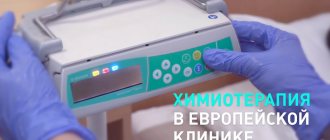Oxaliplatin
The frequency of side effects listed below was determined according to the following gradation: very often (≥1/10), often (≥1/100, <1/10); uncommon (≥1/1000, <1/100); rare (≥1/10000, <1/1000); very rare (<1/10000), including isolated reports; frequency is unknown (it is not possible to determine the frequency of occurrence based on available data).
Combination therapy with oxaliplatin and fluorouracil/calcium folinate
Laboratory and instrumental data:
very often
- increased activity of liver transaminases, alkaline phosphatase, hyperbilirubinemia, increased activity of lactate dehydrogenase, increased body weight;
often
- hypercreatininemia, weight loss.
Infectious and parasitic diseases:
very often -
infections;
often -
upper respiratory tract infections, neutropenic sepsis (including deaths);
infrequently
- sepsis (including deaths).
From the blood and lymphatic system:
very often -
anemia, leukopenia, neutropenia, thrombocytopenia, lymphopenia. The incidence of these side effects is increased when treated with oxaliplatin (85 mg/m2 every 2 weeks) in combination with fluorouracil +/- calcium folinate compared with oxaliplatin monotherapy at a dose of 130 mg/m2 every 3 weeks, for example, the incidence of anemia (80% in compared to 60%), incidence of neutropenia (70% compared to 15%), incidence of thrombocytopenia (80% compared to 40%). Severe anemia (hemoglobin < 8 g/dL) or severe thrombocytopenia (platelet count < 50,000/μL) occurred at similar rates (< 5% of patients when oxaliplatin was used alone or in combination with fluorouracil). Severe neutropenia (neutrophil count <1000/μL) occurred at a higher rate with oxaliplatin in combination with fluorouracil compared with oxaliplatin alone (40% versus <3% of patients).
Often
- febrile neutropenia (including grade 3-4);
rarely -
immunoallergic: hemolytic anemia and thrombocytopenia, disseminated intravascular coagulation, including deaths (see section "Special instructions").
From the digestive system:
very often
- nausea, vomiting, diarrhea, constipation.
Severe diarrhea and/or vomiting may be associated with the development of dehydration, hypokalemia, metabolic acidosis, paralytic ileus, small intestinal obstruction, and renal dysfunction, especially when using a combination of oxaliplatin and fluorouracil. Stomatitis or mucositis (inflammation of the mucous membranes), abdominal pain; often
- dyspepsia, gastroesophageal reflux disease, gastrointestinal bleeding, bleeding from the rectum;
rarely
- colitis, including pseudomembranous colitis caused by
Clostridium difficile ,
pancreatitis.
Liver and biliary tract disorders:
very rarely -
hepatic sinusoidal obstruction syndrome, also known as veno-occlusive liver disease or pathological manifestations associated with this liver disease, including peliosis hepatitis, nodular regenerative hyperplasia, perisinusoidal fibrosis, the clinical manifestations of which may be portal hypertension and/or increased activity of “liver” transaminases in the blood serum.
From the nervous system:
very often
- acute neurosensory manifestations.
These symptoms usually occur at the end of a 2-hour oxaliplatin infusion or within a few hours after administration of the drug and improve spontaneously over the next few hours or days and often recur in subsequent cycles. They may occur or worsen when exposed to low temperatures or cold objects. They are usually expressed in the appearance of transient paresthesia, dysesthesia and hypoesthesia. Acute laryngopharyngeal dysesthesia syndrome occurs in 1-2% of patients and is characterized by subjective sensations of dysphagia or shortness of breath/suffocation without any objective respiratory distress (no cyanosis or hypoxia), or laryngospasm or bronchospasm (no stridor or wheezing). Other sometimes occurring symptoms, in particular cranial nerve dysfunction, both associated with the above adverse events and occurring in isolation: ptosis, diplopia (double vision), aphonia, dysphonia, hoarseness, sometimes described as aphasia; trigeminal neuralgia, facial pain, eye pain, decreased visual acuity, narrowing of visual fields. In addition, the following symptoms were observed: spasm of the masticatory muscles, muscle spasms, involuntary muscle contractions, muscle twitching, myoclonus; loss of coordination, gait disturbance, ataxia, imbalance; feeling of constriction/pressure/discomfort/pain in the throat or chest. Dysesthesia or paresthesia of the limbs and peripheral sensory neuropathy. The limiting toxicity of oxaliplatin is neurological toxicity. It manifests as a peripheral sensory neuropathy, characterized by peripheral dysesthesia and/or paresthesia with or without the development of convulsive muscle contractions, often provoked by cold (85% - 95% of patients). The duration of these symptoms (the severity of which usually decreases between treatment cycles) increases with the number of treatment cycles performed. The occurrence of pain or functional impairment, as well as their duration, are indications for adjusting the dosage regimen or even discontinuing treatment. These functional impairments, including difficulty performing precise movements, are consequences of sensory impairments. The risk of functional impairment for a cumulative dose of approximately 800 mg/m2 (eg, 10 cycles) is ≤ 15%. In most cases, neurological signs and symptoms decrease after cessation of treatment. Dysgeusia (impaired sense of taste), headache. Often -
dizziness, meningism;
rarely -
dysarthria, disappearance of deep tendon reflexes, Lhermitte's symptom, posterior reversible leukoencephalopathy syndrome (see section "Special instructions").
Mental disorders:
often -
depression, insomnia;
infrequently
- nervousness.
From the musculoskeletal and connective tissue side:
very often -
back pain.
If such an adverse reaction occurs, the patient should be examined to exclude hemolysis, as there have been rare reports of its development. Often -
arthralgia, bone pain.
From the respiratory system
,
organs of the chest and mediastinum: very often -
cough, shortness of breath;
often -
hiccups, pulmonary embolism;
rarely -
acute interstitial lung damage, sometimes fatal, pulmonary fibrosis.
From the side of blood vessels:
very often -
nosebleeds;
often -
hot flashes, deep vein thrombosis, thromboembolism, increased blood pressure.
From the kidneys and urinary tract: often
- hematuria, dysuria;
very rarely
- acute tubular necrosis, acute interstitial nephritis, acute renal failure.
From the skin and subcutaneous tissues:
very often
- skin damage;
often -
alopecia (less than 5% of patients with monotherapy), erythematous rash, palmoplantar erythrodysesthesia, increased sweating, changes in the nails.
From the organ of vision:
rarely
- transient decrease in visual acuity, narrowing of visual fields, optic neuritis, transient loss of vision, reversible after treatment.
On the part of the hearing organ:
infrequently
- ototoxicity;
rarely -
deafness.
From the immune system:
very often -
allergic reactions, such as skin rash (in particular, urticaria), conjunctivitis, rhinitis;
often
- anaphylactic reactions, including bronchospasm, angioedema, decreased blood pressure, chest pain and anaphylactic shock.
General disorders and administration site disorders:
very common
- fatigue, fever, chills (tremors) due to infections (with or without febrile neutropenia), or possibly due to immunological mechanisms, asthenia, injection site reactions.
Administration site reactions including pain, flushing, swelling and thrombosis have been reported. Extravasation (entry of the infusion solution with the drug into the tissue surrounding the vein) can also lead to local pain and inflammation, which can be severe and lead to complications, including necrosis, especially when oxaliplatin is administered through a peripheral vein.
Metabolism and nutrition:
very often
- anorexia, hyperglycemia, hypernatremia;
often
- hypocalcemia.
Post-marketing experience
Infectious and parasitic diseases:
frequency unknown -
septic shock (including deaths).
From the blood and lymphatic system:
frequency unknown
- hemolytic-uremic syndrome.
From the nervous system:
frequency unknown
- convulsions.
From the heart:
frequency unknown
- prolongation of the QT interval, which can lead to the development of severe ventricular arrhythmias, including torsade de pointes (TdP), possibly fatal.
From the respiratory system, chest and mediastinal organs:
frequency unknown -
laryngospasm.
From the gastrointestinal tract:
frequency unknown
- intestinal ischemia (including deaths), duodenal ulcer and its potential complications, such as ulcer bleeding and ulcer perforation (including deaths).
Musculoskeletal and connective tissue disorders:
frequency unknown -
rhabdomyolysis (including deaths).
Combination therapy of oxaliplatin with fluorouracil/calcium folinate ( FOLFOX ) and bevacizumab
The safety of the combination of oxaliplatin with fluorouracil/calcium folinate (FOLFOX) and bevacizumab as first-line therapy was assessed in 71 patients with metastatic colorectal cancer (TREE study). In addition to the adverse reactions expected from the FOLFOX regimen, adverse reactions with the combination of FOLFOX and bevacizumab included bleeding, proteinuria, impaired wound healing, gastrointestinal perforation, and hypertension.
For more detailed information regarding the safety of bevacizumab, see the appropriate prescribing information for this drug.
In what cases is chemotherapy used in the treatment of stomach cancer?
Chemotherapy is used for locoregional gastric cancer and metastatic gastric cancer. Below, treatment tactics are presented in more detail depending on the spread of the tumor and the general condition of the patient.
Chemotherapy for locoregional gastric cancer
If stomach cancer spreads beyond the first layer of the stomach wall (the lining), it is called locoregional cancer. Such cancer can spread to nearby lymph nodes, but not to those distant from the stomach (this is already metastatic cancer).
Surgery may be an option for treating locoregional tumors. When the tumor has spread to the second layer of the gastric wall (submucosa), surgery is the main treatment option (stage T1b).
If the tumor has grown beyond the second layer of the stomach wall (T2, T3 or T4 tumors), there are several treatment options, but in most cases (T3 and T4 tumors) chemotherapy is prescribed. Chemotherapy can be given either after surgery or in combination before and after surgery (perioperative chemotherapy).
Chemotherapy regimens recommended before and after surgery (perioperative chemotherapy)
| Preferred Modes | Fluoropyrimidines and oxaliplatin |
| Fluorouracil, leucovorin, oxaliplatin and docetaxel (FLOT) | |
| Other modes used | Fluorouracil and cisplatin |
A combination of chemotherapy and radiation therapy (chemoradiotherapy) followed by surgery is also possible. This is called preoperative chemoradiotherapy.
Chemotherapy regimens recommended for preoperative chemoradiotherapy
| Preferred Modes | Fluorouracil and oxaliplatin |
| Fluorouracil and cisplatin | |
| Fluoropyrimidines (fluorouracil or capecitabine) and paclitaxel | |
| Other modes used | Paclitaxel and carboplatin |
When perioperative chemotherapy or preoperative radiation therapy is given, the doctor will order CT scans of the chest, abdomen, and pelvis to make sure the cancer has shrunk enough to be removed by surgery. In this case, a special contrast is injected into a vein or given as a liquid to drink.
If the required tumor reduction is achieved and there are no contraindications for surgical treatment, surgery is performed.
What are the side effects of chemotherapy for stomach cancer?
The side effects of chemotherapy can vary from patient to patient and depend on the type of drug, the amount of drug taken (dose), and the length of treatment. Common side effects are: lack of appetite, nausea, vomiting, diarrhea, hair loss, inflammation and ulcers of the oral mucosa. Brittleness and discoloration of the nails may also occur.
Some chemotherapy drugs harm sensory nerves. This is called sensory neuropathy. Symptoms include numbness, tingling and pain in the fingers and toes. You may also experience increased sensitivity to cold and pain when touched lightly.
At a consultation with an oncologist at the Rassvet Clinic, you can learn how to prevent or reduce side effects. If you are concerned about a side effect, there may be ways to help you feel better.
What to do if the cancer comes back?
A recurrence that occurs close to where the stomach was located (if you had a complete stomach removal) is called a locoregional recurrence . If the cancer comes back and spreads to areas distant from the stomach, it is metastatic disease .
Treatment of locoregional relapse largely depends on two factors:
- whether your health condition allows surgical treatment,
- whether the spread of the tumor allows for a successful operation.
If surgery is not possible, supportive care may be an alternative (see below “Metastatic gastric cancer”).

